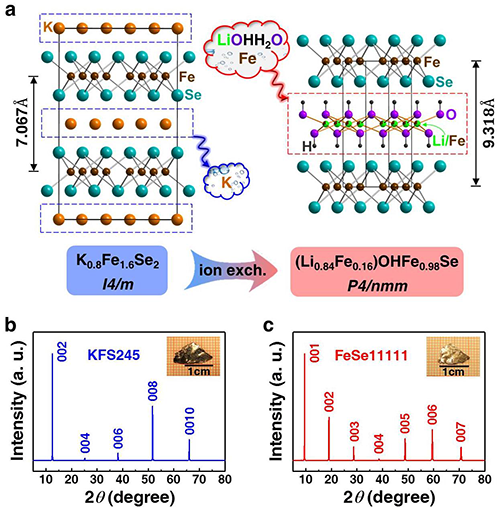New Iron Selenide Superconductor Shows Similar Phase Diagram to Iron Arsenide One and Highly Two-dimensional Electron Properties in Large Single Crystal Ion-exchange Synthesized
Date:12-10-2015 Print
Iron selenide and arsenide superconductors, as the two subgroups of iron-based family, contain similar FeSe4 and FeAs4 tetrahedron layers as their superconducting blocks, respectively. However, the typical FeSe-based superconductor AyFe2-xSe2 (A=alkali metal ions) exhibits quite different physical properties of its parent and normal state phases from the FeAs-based ones. Thus it raises the question of whether the iron-based family would share a universal underlying physics for its high-TC superconductivity. To resolve this issue is of fundamental importance for understanding the physical mechanism of all classes of high-TC superconductors. But in AyFe2-xSe2, the presence of an insulating antiferromagnetic 245 phase obstructs the experimental observation on its intrinsic electronic properties. The appearance of a new FeSe-based superconductor Li0.8Fe0.2OHFeSe in 2014, however, marks a turning point in the experimental studies.
Recently, Prof. DONG Xiaoli (from Institute of Physics, Chinese Academy of Sciences) and her collaborators Dr. JIN Kui (IOP-CAS) and Prof. ZHANG Guangming (Tsinghua University) have made a series of progresses in the study of the new high-TC superconductor system of Li1-xFexOHFe1-ySe.
First, based on a series of powder samples prepared by hydrothermal reactions, they have established a complete electronic phase diagram of Li1-xFexOHFe1-ySe, which shows that the physical properties in both the antiferromagnetic spin-density-wave and superconducting regimes closely resemble those of FeAs-based one. Their results have revealed that the electronic groud states of FeSe- and FeAs-based high-TC superconductors are actually similar to each other, thus a commom mechanism for high-TC superconductivity is expected for the iron-based superconductor family. This work entitled “Phase Diagram of Li1-xFexOHFe1-ySe: A Bridge between Iron Selenide and Arsenide Superconductors” has been published in Journal of the American Chemical Society [http://pubs.acs.org/doi/pdf/10.1021/ja511292f].
One step further, by the application of an ionic exchange technique, the researchers have synthesized a large and high-quality superconducting single crystal (Li0.84Fe0.16)OHFe0.98Se, with a TC = 42 K and an absence of the troublesome 245 phase. This breakthrough in single crystal sample makes it possible to reveal its highly two-dimensional intrinsic electronic properties. They have found a highly two-dimensional charge transport and anomalous linearly temperature dependent susceptibility and resistivity in the normal state below a characteristic temperature T* =120 K, and a strong anisotropy of upper critical field in the superconducting state. Hall coefficient shows that electron carriers dominate the charge transport and the contribution of holes is almost vanishing below this T*. Their results suggest the presence of two-dimensional antiferromagnetic spin fluctuations likely related to the electron pairing for superconductivity, as commonly believed in FeAs-based and cuprate high-TC materials. Moreover, it is shown that an FeSe-based superconductor of a higher TC is of an inevitable enhanced two dimensionality of its crystal and electronic structures; in particular, this high-TC and highly two-dimensional (Li0.84Fe0.16)OHFe0.98Se crystal is a close analogy of an interface superconductor of single unit-cell FeSe film on SrTiO3 substrate showing a TC higher than 65 K. Hence the two-dimensional electron-electron interaction is crucial for high-TC superconductivity in a general sense. This work entitled “(Li0.84Fe0.16)OHFe0.98Se superconductor: Ion-exchange synthesis of large single-crystal and highly two-dimensional electron properties” has been published as Editors’ Suggestion in Physical review B [http://journals.aps.org/prb/pdf/10.1103/PhysRevB.92.064515].
Prof. ZHAO Zhongxian, Prof. ZHOU Fang and Dr. YUAN Jie from IOP-CAS have also made important contributions to the above studies. The Ph.D. candidates, Ms. ZHOU Huaxue, Ms. YUAN Dongna, Mr. HUANG Yulong and Mr. MAO Yiyuan, have been engaged in some related experiments. High-resolution TEM study has been performed by Prof. YANG Huaixin (IOP-CAS), single crystal structural refinement by Prof. SUN Junliang (Peking University), and high temperature magnetism measurement by associate Prof. ZHENG Ping (IOP-CAS).
These studies are supported by projects of Natural Science Foundation of China and the Ministry of Science and Technology of China and by “Strategic Priority Research Program (B)” of Chinese Academy of Sciences.
 |
| Fig. 1. Phase diagram of Li1-xFexOHFe1-ySe system and its micro-structure features |
 |
| Fig. 2. Via a hydrothermal ion-exchange reaction, the insulating matrix crystal K2Fe4Se5 (245 phase) is derived into the superconducting single crystal (Li0.84Fe0.16)OHFe0.98Se, with corresponding changes in the structural features. |
 |
| Fig. 3. The temperature dependences of resistivity, Hall coefficient and susceptibility for superconducting single crystal (Li0.84Fe0.16)OHFe0.98Se, showing a common characteristic temperature of T*=120 K. |
Contact :
Institute of Physics
DONG Xiaoli
Email: dong@iphy.ac.cn
Key Word:
Iron selenide superconductor; phase diagram; two-dimensional properties; single crystal synthesis; hydrothermal ionic exchange.
Abstract:
Whether the iron-based high-TC superconductor family, containing iron selenides and arsenides, would share a universal underlying physics is an important issue to be resolved. A complete phase diagram established for a new high-TC iron selenide system Li1-xFexOHFe1-ySe has bridged the gap between iron selenide and arsenide superconductors, thus a commom physical mechanism is expected. Furthermore, highly two-dimensional electronic properties have been revealed on a large and high-quality superconducting single crystal (Li0.84Fe0.16)OHFe0.98Se prepared via an ion-exchange. The results suggest the presence of two-dimensional antiferromagnetic spin fluctuations likely related to the electron pairing for superconductivity, as commonly seen in iron arsenide and cuprate high-TC materials. It is shown that an iron selenide superconductor of a higher TC is of an inevitable enhanced two dimensionality of its crystal and electronic structures. Hence the two-dimensional electron-electron interaction is crucial for high-TC superconductivity in a general sense.

